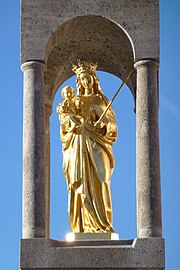Pasinger Marienplatz
| Pasinger Marienplatz | |
|---|---|
| Place in Munich | |
 Pasinger Marienplatz in Dec. 2015 |
|
| Basic data | |
| place | Munich |
| District | Pasing |
| Created | 1880 |
| Newly designed | 2014 (last) |
| Hist. Names | Marienplatz (until 1938) |
| Confluent streets | Bodenseestrasse, Gleichmannstrasse, Landsberger Strasse, Planegger Strasse |
| use | |
| User groups | Pedestrian traffic , bicycle traffic , individual traffic , public transport |
| Space design | Pasinger Marian Column |
The Pasing Marienplatz is the central square of the formerly independent town of Pasing . Pasing has been a district of Munich since 1938 . In order to differentiate the square from Munich's Marienplatz , it has since been given the addition of Pasinger Marienplatz.
history
Based on the model of Munich's Marienplatz, the intersection of the historic Doraxis (today: Planegger Straße) and the former ducal salt road (today: Landsberger Straße and Bodenseestraße) was named Marienplatz. For this purpose, the Pasing Marian column was inaugurated on October 31, 1880 , which at that time consisted of a slender, cast iron column and the statue of the Madonna, which is still used today. The Mariensäule was dismantled as early as 1908 because the new tram line (line 19 and at times also 29) had its end point here and space was needed for shunting tracks and a turning loop.
As a result of the increasing traffic, an elongated traffic island was created on Marienplatz , where cars could initially be parked. Later there was a taxi stand immediately around the traffic island.
After the association Pasinger Mariensäule eV campaigned for the rebuilding of the Mariensäule from 1977 , the square was redesigned again in 1980. A triangular traffic island was created with the Marian column in the middle. On the new square base was another square pillar, at the top of which a canopy was attached in which the statue of the Madonna stood. As before, the statue was facing north towards the so-called Kopfmiller House . The edge of the traffic island was fenced in by pillars and chains up to the north side, and around the column there were several wide, barrel-like flower pots.
As part of the redesign and traffic calming of the Pasing center through the construction of the northern bypass Pasing , Marienplatz was rebuilt from 2013 and the Marian column was moved slightly to the north. According to plans by the landscape architects Burger and Kühn , the old pillar is now on a circular base, around which rings made of light granite and dark basalt have been grouped. The viewing direction of the statue was turned towards the east (i.e. towards Munich).
location
Marienplatz is bordered in the north by the Gasthof zu Post and the Kopfmiller House . On the east side are the so-called Kring-Haus and the Röder-Haus , which house retail stores. This is followed by the pharmacist's house with the St. Jakobs pharmacy founded in 1880; one of the former owners was Fritz Dürrfeld .
The English Misses' Institute closes off the south side of Marienplatz . On the west side is the so-called cardboard box , a makeshift building with shops and restaurants from the time between the two world wars, the small Marienbrunnen created in 1921 and the listed Confetti House .
traffic
The center of Pasing has been burdened by heavy traffic in the last few decades, which has made the district less attractive and also limited the development opportunities for retailers. The B 2 , which previously ran over Marienplatz, was relocated to the Pasing northern bypass at Pasing train station at the end of 2012 and Marienplatz was freed from east-west through traffic. The tram has been extended to Pasinger Bahnhof and now only touches Marienplatz on the edge when it turns from Gleichmannstrasse coming from the north into Landsberger Strasse leading to the east. For cars, this is the only way to drive on Marienplatz in addition to the option to turn from Bodenseestrasse, which runs from the west into Planegger Strasse, which runs southwards (and vice versa). Only buses and taxis are still allowed to cross the square from Planegger Straße .
criticism
The redesign of the Pasinger Marienplatz is assessed differently. The enormous decrease in the previous traffic load and the idea of creating a pedestrian zone are often positively emphasized. Critics complain, however, that the place appears dull and empty due to the lack of planting (flowers or trees) or the lack of seating and thus does not become a meeting place. The metal chairs that were set up at a later date could also provide a temporary solution. It is also criticized that the pattern of the pavement only achieves its effect from an aerial perspective and that it appears unstructured from the ground. In addition, some critics, as in the past, lack an enclosure around the base of the Marian column so that B. prayers could be said in a separate area, or repeated damage to the lamp on the base by road users could be prevented.
Web links
- Pasinger Marienplatz on muenchen.de
- Northern bypass Pasing on muenchen.de
Individual evidence
- ^ Renate Mayer-Zaky, Reinhard Bauer: Pasing - The district book. Bavarica-Verlag, Munich 1996.
- ↑ youtube.com
- ↑ Thomas Hasselwander (Ed.): Pasinger Archive. Edition 2016.
Coordinates: 48 ° 8 ′ 48 ″ N , 11 ° 27 ′ 33 ″ E


